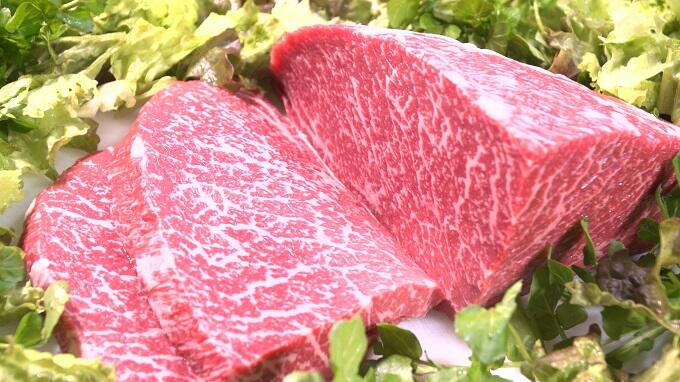Kumamoto Akaushi
| Registration Number | 67 |
|---|---|
| Name of the GI | Kumamoto Akaushi |
| Class | Meat |
| Date of Protection | 2018/09/27 |
| Producing Area | Kumamoto Prefecture |
| Applicant - Name and Address | Association for Promotion of Kumamoto Beef Consumption 6-3-54 Sakuragi, Higashi-ku, Kumamoto City, Kumamoto Prefecture |
Producing Area
Kumamoto Akaushi is a beef from Japanese Brown (Akage
Washu) (1) cattle raised primarily in Kumamoto Prefecture and whose final breeding location is in Kumamoto Prefecture.
Kumamoto Akaushi contains much lean red meat with moderate fat marbling, marrying light flavor and tenderness. It is high in free amino acids that give rise to umami flavor compared to the Japanese Black(Kuroge Washu), and is rich in glycogen that gives rise to mild tastes.
The breed of Kumamoto Akaushi is defined as Japanese Brown, calves with a Certificate issued by the Nihon Akaushi Touroku Kyokai, (Japan Akaushi Registry Association) or an equivalent certificate.
The farming requirements of Kumamoto Akaushi are that the cattle have been fattened for a period of 12 months or longer and that their primary and the final breeding location is in Kumamoto Prefecture.
Carcass requirements are that they are from steers or heifers and that they are rated second grade or higher (generally fourth grade or lower) in terms of meat quality based on the Beef Carcass Trading Standards set by the Japan Meat Grading Association.
Kumamoto Prefecture, the production area of Kumamoto Akaushi, is located in the center of Kyushu, the third largest island of Japan's five main islands, and has a long history of farming Akaushi on pasture mainly in the Aso region (2), which has one of the world's largest caldera.
In the Meiji era (3), efforts to improve the breed of Akaushi were initiated by introducing foreign breeds, resulting in development of a larger breed by crossing smaller Akaushi cattle with the Swiss Simmenthal as the stud bull. As a result of subsequent efforts to achieve true-breeding, the Kumamoto line of Japanese Brown was certified as one of the Japanese traditional meat breed Wagyu in 1944.
The breed improvement focused on adaptability to pasture mainly in the Aso region such as lower body musclestrength and roughage utilizations instead of focusing on fat marbling, which resulted in a higher content of lean red meat.
Stud bulls of the Kumamoto Japanese Brown are managed exclusively by the Kumamoto Prefectural Agricultural Research Center, which carries out the breed improvement of the Japanese Brown and its conservation, including the first-in-Japan production of stud bulls by the use of fertilized egg transplantation, breeding and conservation of rare breeds, along with the production of Japanese Brown cattle using dairy breeds raised by cattle farmers in the prefecture.
As of 2017, 14,500 Japanese Brown cattle are farmed in Kumamoto Prefecture, which accounts for approximately 70% of the total Japanese Brown cattlein Japan.
In particular, approximately 70% of Japanese Brown breeding cattle in the prefecture are farmed in the Aso region, where the breed was first developed, and most of these are pastured.
- Japanese Brown: One of the four native Japanese beef cattle breeds along with the Japanese Black, the Japanese Polled, and the Japanese Shorthorn. The breed has large body size, is gentle in nature, and suitable for pasturing. Meat is characterized by high lean red meat with moderate fat marbling and rich flavor.
- Aso region: The region having one of the world's largest caldera stretching approximately 18 km from east to west and approximately 25 km from north to south around the active volcano Mount Aso. The area is designated as Aso Kuju National Park, which is one of the nation's best tourist destinations scattered with hot springs and other places for sightseeing and leisure activities.
- Meiji era: An era of Japanese history from 1868 to 1912, which saw the transition of the country from the feudal government to a modern state.


